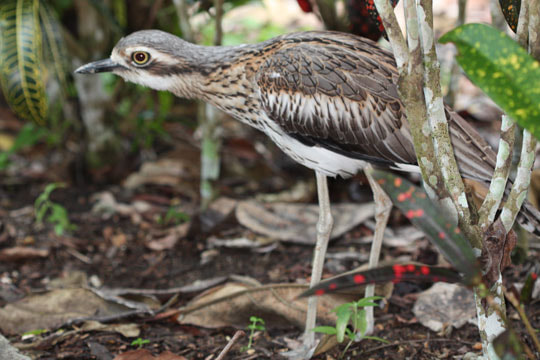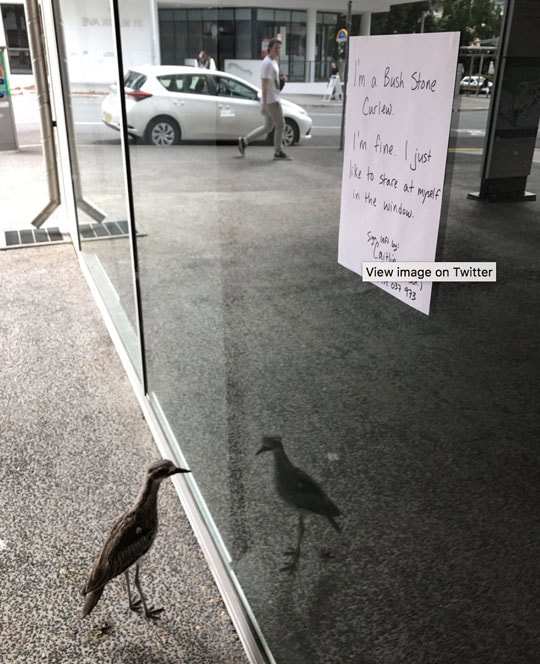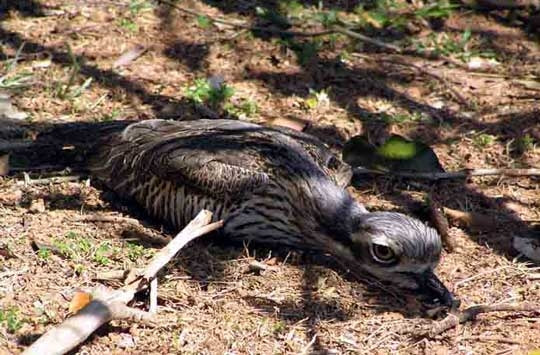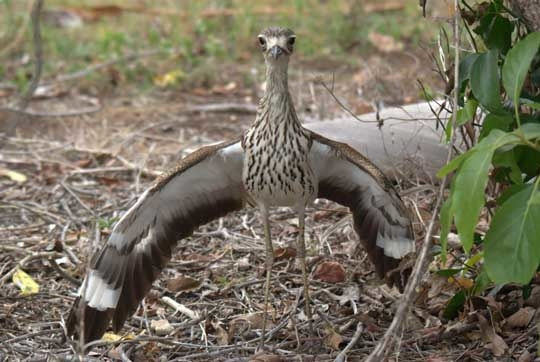|
For your reading pleasure today, I am featuring the Bush Stone-Curlew as the awesome animal. Why? Two reasons. First, because today is the release date of y new novel, Bridgers 1: The Lure of Infinity. Bridgers 1 is filled with strange birds, and the bush stone-curlew is definitely a strange bird. Second, we saw stone-curlews on our Australia trip, and I think they are, well, simply awesome. So what the heck is a Bush Stone-Curlew? The Bush Stone-curlew is a rather strange-looking bird with extremely long legs and large eyes. It is a predatory bird that lives in all but the driest areas of Australia, although it has decreased significantly in recent decades. Here is a photo of one of the bush stone-curlews we saw in northeast Australia: Amazing facts about Bush Stone-Curlews Stone-curlews are primarily predators. They hunt in areas where there are fallen leaves and sticks they can sort through and small logs they can pick apart. They do this to find a variety of insects, lizards, small snakes, crabs, and even rodents. They hunt mainly at night, which is why their eyes are so large (looking similar in some ways to owl eyes). Stone-curlews love to stare at their own reflections. This is an unusual behavior that has been observed on many occasions. In fact, stone-curlews have become brief social media stars when photos of them staring into windows have gone viral. Often they will become so transfixed with their own reflection that they will return to the same window day after day, standing motionless and staring for hours each day. This behavior can probably be explained by several facts. First, stone-curlews have a defense strategy that involves standing or squatting motionless. Perhaps when they see their reflection, they think it is another bird and they freeze. It could be a variation of the common bahavior of birds fighting with themselves in the mirror. Anyway, the photo below is a stone-curlew that kept returning to this window so regularly that a volunteer with Wildcare Australia put up this sign (it says: "I’m a bush stone curlew. I’m fine. I just like to stare at myself in the window."). Stone-curlews are rarely seen doing their courtship behaviors. Why? Because once they find a mate, they stay paired together for life... as long as 30 years! Their courtship behavior must be spectacular to see because those people who have been lucky enough to witness it have described it as a "glee party" and a "whistling concert." Speaking of the stone-curlew's call, these birds have sometimes been nicknamed the "screaming woman bird." Their call is a high, mournful, piercing shriek. This may be why aboriginal Australians have associated the bird with suicide and death. Check out this video of a stone-curlew calling. Curlews can also growl or hiss. When Trish and I came upon three stone-curlews at the edge of a soccer field, I tried to approach them to get a better photo. They responded by growling at me. This is a common behavior when they feel threatened. Check out this video of a growling curlew. As another means of defense, the stone-curlew will often freeze, apparently attempting to blend in with its background. The thing is, it tends to freeze immediately, even when it is currently in a strange position. So if you see a dead-still curlew standing on one leg or squatting, this is why. See photo below. Although stone-curlews have declined in much of their range (endangered in New South Wales, threatened in Victoria), they adapt very well to human presence in Queensland (northeast Australia). In Brisbane, they inhabit the shopping districts, hanging out without moving near shrubbery during the day, rarely noticed by all the people. And at night they happily feed on the insects and geckos that congregate around the bright lights. They have even been seen collecting cigarette butts and lining their nests with them, possibly because the nicotine acts as an insect repellent. Speaking of their nests, when stone-curlews feel that their nests are being threatened, they often spread their wings and raise a noisy ruckus to scare aware potential predators. See photo. So, the bush stone-curlew deserves a place in the G.A.H.O.F. (Gnarly Animal Hall of Fame). FUN FACT: The word gnarly first meant bumpy or twisted (as in, he has gnarly fingers). Eventually (particularly in surfing) it became a word to describe something very difficult or bad (he had a gnarly wipeout on that wave). And then finally, it came to mean very good. As in, that dude can do some gnarly guitar playing! So gnarly is another way to say awesome! Photo Credits:
Stone Curlew #1 - Stan C. Smith Stone-curlew staring at reflection - ABC News Stone-curlew freezing - David Cook - Canberra Birds Stone-curlew in threatening posture - Land for Wildlife
0 Comments
Leave a Reply. |
Stan's Cogitations
Everyone needs a creative outlet. That's why I write. Archives
July 2024
|





 RSS Feed
RSS Feed